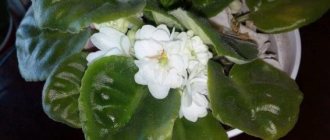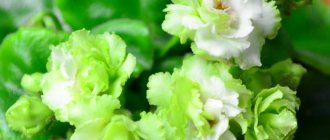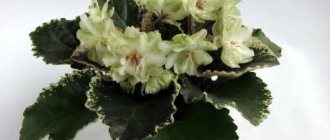Violets are considered capricious plants, and not every amateur gardener can find a common language with them the first time. It is quite difficult to find such a place on the windowsill so that the delicate leaves of these flowers do not get scorched from the summer heat. The ideal location for them is considered to be eastern and northern windows, but it often happens that even in ideal conditions, the violet refuses to bloom, and its leaves fade. It is even more difficult to propagate a plant, especially if it is a rare variety. The cuttings rot in water or dry out without producing offspring.
But this is not the case with the antique Paul Bunyan violet. This variety may have stood on the windowsills of our grandmothers, delighting them with its flowering. The flower is very unpretentious, it is able to grow in almost any conditions: in bright sun or in almost complete darkness. Of course, its small double inflorescences are difficult to compete with chic modern hybrids, but with its vitality it is winning more and more fans. The flowers of the Paul Banyan violet come in several shades: from lilac-violet to almost blue. This classic color looks equally good in any interior.
Features of the variety
Even a novice florist who has not previously been familiar with the agricultural technology of violets will be able to grow the Saintpaulia variety Paul Banyan and bring it to flowering. Improper watering, drying, insufficient lighting - it can withstand any adversity. Of course, with this variety you won’t be able to train yourself to care for other, more capricious violets. But decorating your windowsill with an abundantly flowering large plant is a must.
Saintpaulia Paul Bunyan (Storytella) has small, approximately 2.5 cm in diameter, lilac flowers with a slight shine, in the shape of a star. Additionally, they are decorated with venous veins. The leaves are quite large, light green in color, on long petioles, and heavily pubescent. The rosette is a standard size and grows very quickly: the flower is often divided into several rosettes. Because of this, the plant has to be replanted frequently to separate the children. The peduncles are tall, but in insufficient light they hide under the leaves. It blooms for a long time, throughout the season, sometimes even in winter.
Properties
Name
- Original: JuS-Adelina
- Transcription:
- Translation:
Registration
- Selection: S. Dzhura (Pikalenko)
- Year: 2013
Socket
- Socket type: standard
Flower
- Flower size, up to: 6 cm
- Flower shape: star
- Terry size: semi-double, terry
- Main color: red-raspberry
- Color type: plain
- Border: double
- Other Features
Foliage
- foliage color: medium green
- foliage type: simple
- foliage shape: heart-shaped; quilted
- reverse side of sheet: red
- leaf edge: jagged edge
- variegation: crown (Champion)
Propagation of Saintpaulia Paul Banyan in a jar of water
Violets can be propagated by dividing the bush or leaf cuttings at any time of the year, but best in the spring. They take root easily even in water, and often produce babies along the stem. The leaf needs to be cut with a sharp knife at an angle of 45 degrees, but the cuttings take root well, even if they are simply broken off from the bush and stuck in the ground. It is advisable not to cut off a shoot that is too long; 4 cm will be enough. When using the water method, the first roots appear after 3 weeks. If there are not too many leaves for violet propagation, it is advisable to play it safe and make a special “holder” for the leaf, which will not allow the bottom part to touch the bottom of the jar. To do this, take a regular sheet of paper, make a cut in the center and put it on top of the container, wrapping it with twine.
Minor difficulties
Many have encountered such a problem as yellowing and falling of the lower leaves of the “Violet”.
After which the plant loses its former harmony and beauty. In these cases, experienced flower growers and amateurs use the “Violet” method of rejuvenation, which helps to restore its former harmony and the ability to bloom again. To carry out rejuvenation, the following actions are necessary:
The first thing you need to do is remove all the flower stalks on the violet. Then, you need to cut off the crown from the rosette of the plant, and then let it dry a little, on average 15 minutes will be enough. Then place the top of the head in a container of water. For better rooting of the plant, it is necessary to dissolve 1-2 tablets of activated carbon in water for the plant. Instead of a cut leaf, a stump remains, which will give away the stepsons. Within 2 months, the plant will form good roots, after which they can be planted in the soil mixture.
Cuttings in soil
You can do it differently by planting the cuttings directly in the ground or in a peat tablet. Usually such leaves are covered with a bag, creating greenhouse conditions, but this is not necessary for the Paul Bunyan violet. It is enough to pour boiling water over the soil or peat tablet for disinfection, cool it and place the cut cutting there. Sometimes, in order not to replant the baby, gardeners plant the leaf directly into the pot, but then they will have to wait a long time for the first flowering, because the young plant will spend energy growing roots until it fills the entire volume of soil. That is why they try to take small containers for planting young violets, for example ordinary transparent plastic cups. The roots and the amount of moisture remaining in the soil are visible in them, so it will immediately be clear when to water the flower. If the fear of losing a plant cutting is too great, you can cover it with a jar on top or put it in a greenhouse. But then the plant will need to be gradually accustomed to dry air, removing the can for a while and increasing the interval.
Reproduction by dividing the bush
One of the features of the blooming violet Paul Bunyan is the constant formation of children on the mother bush. Because of this, the plant becomes deformed and loses its attractive appearance, so it requires regular replanting with separation of the shoots. The cut babies are often without roots, but they can be turned into full-fledged violets by cleaning the trunk, dipping it in a root enhancer and placing it in a water bottle. It is important that the growing point is not flooded, otherwise the plant will rot. Due to limited air access, the water in the tank must be changed regularly. When the roots appear, the violet is transplanted into the ground. Children with roots are already young plants: they can simply be separated from the mother plant and transplanted into another container. The plant is placed on a light windowsill and watered into a tray with settled water at room temperature. You can feed after a month.
Information about breeder Tatyana Pugacheva
Attention : Tatyana Pugacheva was born in 1975. Regularly participates in Russian and international exhibitions, gives lectures at the Moscow House of Violets. Together with her colleague Natalya Skornyakova, she runs the Kursk Violet website, where about 100 varieties she has bred are presented. The collection is constantly updated.
Tatyana Pugacheva is the creator of such varieties as “Vanessa”, “Reed Dance”, “Yaroslava”, “Natalie”, “Painted Veil”, “Elenika”, “Nonna”, “Heavenly Tent”, “Jacqueline” and many others. In catalogs, Tatyana Pugacheva’s violet varieties are indicated with the prefix “PT” . Let's take a closer look at some of them.
Soil for violets
A special soil mixture for Saintpaulias can be purchased at a flower shop or prepared independently by mixing one part of sand, peat and 4 parts of leaf soil. Sometimes coniferous soil and raising agents are added: perlite, vermiculite. Perlite is better suited because it does not retain excess moisture. The soil must be nutritious so that the violet has the strength to bloom. Some gardeners, in order to make it easier for themselves to care for a large collection, use “wick watering”. It allows you to protect plants from waterlogging or drying out of the earthen coma.
Lighting
"Violets" require a very large amount of light or lighting.
Lighting can be either natural or artificial, using fluorescent lamps. In natural light, it is very important to protect plants from direct sunlight. As a rule, there is not enough natural light, and an additional 2-4 hours of artificial lighting are used. If the plants are located on the South side, then it is desirable that the light falling on the violets be diffused. This can be done with a curtain or use tulle. If you use artificial daylight, then you can achieve the desired conditions for growing violets. Lighting is usually needed for more than 12 hours a day. Lack of light causes leaves and petioles to lengthen. The density of the leaves and their contrast are also lost. It is necessary to periodically rotate the flower, changing its position, this will prevent deformation of the leaves, which also occurs with a lack of light. The plant will receive less light if the leaves contain dust. Lack of light is the first reason for the lack of flowering in “Violet”.
Wick watering
You can make a wick when planting a plant using a special cord. Along it, as much moisture will rise to the roots of the plant as is necessary for normal growth and development. The main condition: make a special soil without adding soil, otherwise the violets may die. For wick irrigation, use a mixture of peat, vermiculite and perlite. Sometimes coconut substrate is added. A cord rolled into a ring is placed at the bottom of the pot, and its tip is brought out through the hole. Then soil is poured on top and a flower is planted in it. You need to place the plant in a pan of water so that the soil is saturated, and then in a container with water, where the other end of the cord will be located. All that remains is to regularly add liquid and nutrient solutions, because perlite and moss do not contain the microelements necessary for violets. The disadvantage of this method is that in winter such plants will require additional heating: the water in the containers will greatly cool the root system, and this can cause rotting of the roots and rosettes.
Selection of a pot for violets
The pots for violets are chosen to be small in size; its diameter should correspond to approximately 2/3 of the rosette. In pots that are too large, the plant will take a long time to grow root mass and greenery, rather than bloom. In addition, too much soil can lead to overwatering of the plant if the roots of the flower do not have time to absorb water. But for growing Paul Bunyan violets, it is better to take slightly larger containers than for other violets, because this variety grows very quickly and can produce many children.
Saintpaulias do not like clay pots because they get very wet, and high humidity increases the risk of infection with fungal diseases. It is better to take a light plastic container that does not heat up in the sun and does not become saturated with moisture. Violets are not planted in glazed heavy pots because they do not “breathe”.
Diseases and pests
Pests of the variety include :
- Whitefly;
- Cyclamen mites;
- Thrips;
- Mealybugs;
- Root-knot nematodes;
- Gray rot;
- Powdery mildew;
- Fungus gnats;
- Vascular bacteriosis.
Important! The Paul Banyan variety is less likely to get sick and is less susceptible to pest damage than other violets.
Prevention of diseases and pests:
- Proper watering;
- Ensuring good ventilation;
- Quality soil;
- Maintaining temperature conditions.
Caring for Saintpaulia Paul Bunyan
This variety of violet is extremely undemanding in terms of keeping conditions, but for abundant flowering it is advisable to provide it with a bright windowsill, without access to direct sunlight, and with enough space. The comfortable temperature for the Paul Bunyan violet is 20 degrees Celsius. Water the plant moderately, with warm water in a tray, but it will survive surface watering, although this often rots other varieties. The main thing is that liquid does not get into the center of the outlet. The plant cannot be sprayed because the leaves are pubescent - then spots appear on them. In summer, violets are fed with complex fertilizer or organic matter. Replant as needed when the flower grows. Diseased and damaged leaves are removed, leaving a small stump; the sections can be treated with activated carbon. Caring for the Saintpaulia variety Paul Banyan is quite simple and does not cause difficulties even for novice gardeners. The plant is rarely damaged by pests and practically does not get sick.
Violet Paul Bunyan: description, cultivation features and reviews
In winter, this variety can withstand some shading, but it is better to place it under lamps if possible. Then the violet will delight its owners with new buds for most of the year. Although, by modern standards, flowering is considered inconspicuous, few varieties can boast of such abundant and long-lasting flowering. Judging by the descriptions and reviews of the Paul Bunyan violet on plant lovers forums, this variety is unpretentious and profusely flowering, but it does not like close proximity to other plants. When leaves come into contact with an obstacle, they can rot. It is advisable to place the flower in a place where there are no drafts, and the distance to neighboring pots or other objects is at least 3 cm. This variety does not require any special growing conditions; even with minimal care, the Saintpaulia variety Paul Banyan will delight the owner with abundant flowering and a beautiful even rosette of a pleasant green color.
Temperature
Comments from experienced florists or growers helped determine the most optimal temperature for breeding and propagating violets. The optimal temperature is 20-25 °C. In adult violets, flowering lasts longer, at a temperature of 20 ° C. The flowers are larger. For young violets, for better development and growth, it is better to maintain a temperature slightly above 24-25°C. In winter, violets feel quite good at temperatures of 15-17 °C. The minimum temperature for violets is 10 °C. A decrease in temperature does not greatly affect the condition of the plant, except for a decrease in growth; it is necessary to exclude sudden changes in temperature. Drafts of cold air also have a negative impact. It is necessary to take into account the place where the flower is located; if the window sill is cold, then it is better to move the flower to a warmer and well-lit place. Be sure to take into account the climatic features of the region.











